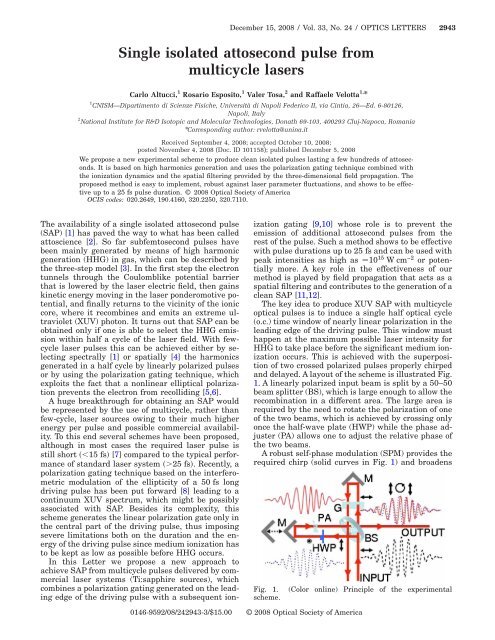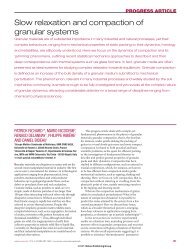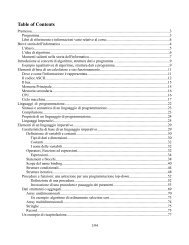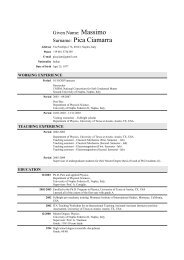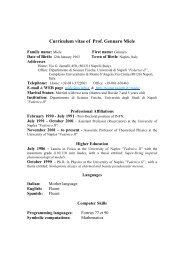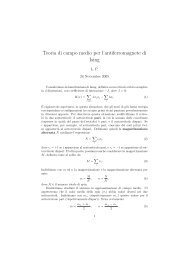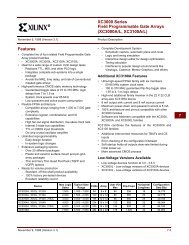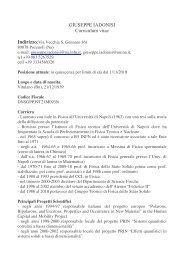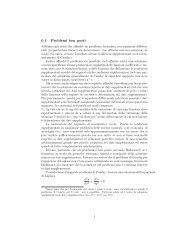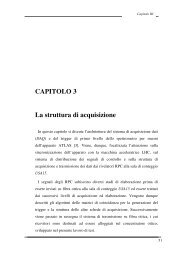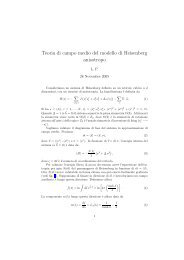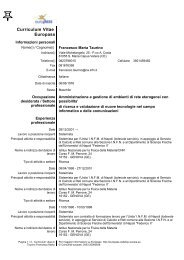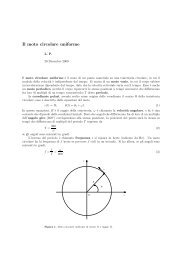Download PDF - Optics InfoBase
Download PDF - Optics InfoBase
Download PDF - Optics InfoBase
Create successful ePaper yourself
Turn your PDF publications into a flip-book with our unique Google optimized e-Paper software.
Single isolated attosecond pulse from<br />
multicycle lasers<br />
Carlo Altucci, 1 Rosario Esposito, 1 Valer Tosa, 2 and Raffaele Velotta 1, *<br />
1<br />
CNISM—Dipartimento di Scienze Fisiche, Università di Napoli Federico II, via Cintia, 26—Ed. 6-80126,<br />
Napoli, Italy<br />
2<br />
National Institute for R&D Isotopic and Molecular Technologies, Donath 69-103, 400293 Cluj-Napoca, Romania<br />
*Corresponding author: rvelotta@unina.it<br />
Received September 4, 2008; accepted October 10, 2008;<br />
posted November 4, 2008 (Doc. ID 101158); published December 5, 2008<br />
We propose a new experimental scheme to produce clean isolated pulses lasting a few hundreds of attoseconds.<br />
It is based on high harmonics generation and uses the polarization gating technique combined with<br />
the ionization dynamics and the spatial filtering provided by the three-dimensional field propagation. The<br />
proposed method is easy to implement, robust against laser parameter fluctuations, and shows to be effectiveuptoa25<br />
fs pulse duration. © 2008 Optical Society of America<br />
OCIS codes: 020.2649, 190.4160, 320.2250, 320.7110.<br />
The availability of a single isolated attosecond pulse<br />
(SAP) [1] has paved the way to what has been called<br />
attoscience [2]. So far subfemtosecond pulses have<br />
been mainly generated by means of high harmonic<br />
generation (HHG) in gas, which can be described by<br />
the three-step model [3]. In the first step the electron<br />
tunnels through the Coulomblike potential barrier<br />
that is lowered by the laser electric field, then gains<br />
kinetic energy moving in the laser ponderomotive potential,<br />
and finally returns to the vicinity of the ionic<br />
core, where it recombines and emits an extreme ultraviolet<br />
(XUV) photon. It turns out that SAP can be<br />
obtained only if one is able to select the HHG emission<br />
within half a cycle of the laser field. With fewcycle<br />
laser pulses this can be achieved either by selecting<br />
spectrally [1] or spatially [4] the harmonics<br />
generated in a half cycle by linearly polarized pulses<br />
or by using the polarization gating technique, which<br />
exploits the fact that a nonlinear elliptical polarization<br />
prevents the electron from recolliding [5,6].<br />
A huge breakthrough for obtaining an SAP would<br />
be represented by the use of multicycle, rather than<br />
few-cycle, laser sources owing to their much higher<br />
energy per pulse and possible commercial availability.<br />
To this end several schemes have been proposed,<br />
although in most cases the required laser pulse is<br />
still short 15 fs [7] compared to the typical performance<br />
of standard laser system 25 fs. Recently, a<br />
polarization gating technique based on the interferometric<br />
modulation of the ellipticity of a 50 fs long<br />
driving pulse has been put forward [8] leading to a<br />
continuum XUV spectrum, which might be possibly<br />
associated with SAP. Besides its complexity, this<br />
scheme generates the linear polarization gate only in<br />
the central part of the driving pulse, thus imposing<br />
severe limitations both on the duration and the energy<br />
of the driving pulse since medium ionization has<br />
to be kept as low as possible before HHG occurs.<br />
In this Letter we propose a new approach to<br />
achieve SAP from multicycle pulses delivered by commercial<br />
laser systems (Ti:sapphire sources), which<br />
combines a polarization gating generated on the leading<br />
edge of the driving pulse with a subsequent ion-<br />
December 15, 2008 / Vol. 33, No. 24 / OPTICS LETTERS 2943<br />
ization gating [9,10] whose role is to prevent the<br />
emission of additional attosecond pulses from the<br />
rest of the pulse. Such a method shows to be effective<br />
with pulse durations up to 25 fs and can be used with<br />
peak intensities as high as 10 15 Wcm −2 or potentially<br />
more. A key role in the effectiveness of our<br />
method is played by field propagation that acts as a<br />
spatial filtering and contributes to the generation of a<br />
clean SAP [11,12].<br />
The key idea to produce XUV SAP with multicycle<br />
optical pulses is to induce a single half optical cycle<br />
(o.c.) time window of nearly linear polarization in the<br />
leading edge of the driving pulse. This window must<br />
happen at the maximum possible laser intensity for<br />
HHG to take place before the significant medium ionization<br />
occurs. This is achieved with the superposition<br />
of two crossed polarized pulses properly chirped<br />
and delayed. A layout of the scheme is illustrated Fig.<br />
1. A linearly polarized input beam is split by a 50–50<br />
beam splitter (BS), which is large enough to allow the<br />
recombination in a different area. The large area is<br />
required by the need to rotate the polarization of one<br />
of the two beams, which is achieved by crossing only<br />
once the half-wave plate (HWP) while the phase adjuster<br />
(PA) allows one to adjust the relative phase of<br />
the two beams.<br />
A robust self-phase modulation (SPM) provides the<br />
required chirp (solid curves in Fig. 1) and broadens<br />
Fig. 1. (Color online) Principle of the experimental<br />
scheme.<br />
0146-9592/08/242943-3/$15.00 © 2008 Optical Society of America
2944 OPTICS LETTERS / Vol. 33, No. 24 / December 15, 2008<br />
the initial spectrum centered at 800 nm toward the<br />
infrared/visible in the leading/trailing edge of the<br />
pulse. In view of the role played by the ionization gating<br />
only the first half of the pulse needs to preserve<br />
its spectral and temporal attributes. The main effect<br />
to be concerned about is the group velocity dispersion<br />
(GVD) occurring in all the crossed optics, which<br />
would lead to pulse lengthening. Since in our method<br />
the SAP is generated in the leading edge of the<br />
chirped pulse, we can neglect GVD contribution because<br />
its importance tends to vanish for wavelengths<br />
longer than 800 nm in most materials (e.g., Ga:La:S<br />
glasses). Possible residual positive GVD can be corrected<br />
through negative dispersive systems.<br />
Eventually, the output of the interferometer is a<br />
superposition of two crossed linearly polarized<br />
beams, E x and E y, the latter being chirped and delayed,<br />
2<br />
p E yt,z = E 0y exp− 1.39 t − T d<br />
sin− 0t − T d<br />
+ 2L<br />
n 2It − T d − z + 0y. 1<br />
In Eq. (1) E 0y=E 0/2 with E 0 being the input electric<br />
field amplitude, T d is the relative delay between<br />
the output pulses, p is the input pulse duration<br />
[FWHM of the intensity It], 0 is the main oscillation<br />
frequency, L and n 2 are the thickness and the<br />
nonlinear refractive index, respectively, of the glass<br />
where SPM takes place, z is the Guoy phase, and<br />
0y is the carrier to envelope phase (CEP). Similarly,<br />
E x is described by Eq. (1) without the SPM term with<br />
E 0x=E 0/2 and setting T d=0.<br />
The maximum SPM-induced phase variation experienced<br />
by the electric field has been assumed to be<br />
9 rad. It can be easily realized by a laser beam with<br />
an intensity of 50 GW/cm 2 crossing a 2-mm-thick<br />
slab of high n 2 glasses, such as SF59 or Ga:La:S n 2<br />
=50–10010 −16 cm 2 /W. We neglect here a possible<br />
spatial variation of the induced SPM owing to radial<br />
modulation of the pulse intensity. Such an assumption<br />
relies on the possibility to enlarge the beam size<br />
and then select only its central part. The value of<br />
9 rad for the SPM-induced phase variation is a tradeoff<br />
between a higher value that would generate more<br />
linear polarization windows and a lower value that<br />
would broaden the single time window. In both cases<br />
multiple attosecond pulses would be produced.<br />
The superposition of the two fields given by Eq. (1)<br />
leads to an electric field with a linear polarization<br />
quite close to the peak intensity, elliptical at maximum<br />
intensity, and again linear after the peak. This<br />
is shown in detail in Fig. 2(a), where the ellipticity<br />
=E yt/E xt is reported for a laser pulse with p<br />
=20 fs. In this simulation the delay between the two<br />
pulses is T d=−0.32 fs (chirped pulse ahead), while<br />
the CEP is 0.4 rad. The two pulses are in phase <br />
=0 only for approximately half a cycle, thus realizing<br />
the single emission, which is the main requirement<br />
for the generation of SAP. This condition takes place<br />
Fig. 2. (Color online) (a) Ellipticity (blue dotted curve),<br />
ionization fraction (green thin solid curve), single dipole<br />
emission (red thick solid curve), and near-field emission<br />
(black dashed curve) versus time for a p=20 fs pulse. The<br />
spectral window is H20–H44 of the fundamental, while<br />
other conditions are specified in the text. (b) Chirped (E y,<br />
red solid curve) and chirp-free (E x, blue dotted curve)<br />
squared electric fields.<br />
once in every time window centered at cusp points<br />
=0, in the leading edge of the laser pulse; however,<br />
the recollision events leading to harmonic emission<br />
in the spectral interval H20–H44 occur mainly in the<br />
time window at t−3.5 o.c., since in the former t<br />
6.3 o.c. the pulse intensity is still too low for an effective<br />
HHG. The central part of the pulse is intense<br />
enough to fully ionize the medium while the condition<br />
T d=−0.32 fs assures that the ellipticity is quite<br />
high 0.7 at the peak of the combined pulse. The<br />
above two factors impede further contributions to the<br />
harmonic field from the rest of the pulse. Such a description<br />
is supported by the single dipole emission,<br />
shown in Fig. 2(a), calculated within the strong field<br />
approximation generalized for a field with timedependent<br />
ellipticity [13].<br />
Nonadiabatic three-dimensional (3D) propagation<br />
of fundamental and harmonic fields through to the<br />
gas target has been accounted for by extending the<br />
model described in [14] to the case of two fields and<br />
by numerically integrating the corresponding propagation<br />
equations for both fundamental and harmonic<br />
fields. Medium ionization has been calculated by using<br />
the nonadiabatic Ammosov–Delone–Krainov<br />
model. Throughout our simulations we have assumed<br />
a pulse peak intensity at a focus of 810 14 Wcm −2<br />
and a 1-mm-long Ar jet of 3.310 3 Pa local pressure<br />
placed at 1.7 mm in the diverging beam, 3.5 mm being<br />
the confocal parameter.<br />
Our method to generate SAP from multicycle highenergy<br />
optical pulses has been found to be very robust<br />
against CEP fluctuations. Specifically, in Fig.<br />
3(a) the total near-field emission is reported as a<br />
function of time for three different CEP values showing<br />
that a very clean SAP lasting about 380 as is obtained<br />
at t−3.5 o.c. with CEP equal to 0.4 rad.<br />
When CEP shifts by ±0.2 rad an additional satellite<br />
[not shown in Fig. 3(a)] appears, having an intensity<br />
eight times smaller than the main pulse. The temporal<br />
structure degenerates to a double-pulse structure<br />
when CEP shifts by more than ±0.3 rad from the
Fig. 3. (Color online) (a) HHG emission in the near field<br />
versus time for p=20 fs, T d=−0.32 fs (chirped pulse<br />
ahead), and CEP=0 rad (blue dotted–dashed curve), CEP<br />
=0.4 rad (black solid curve), and CEP=0.75 rad (red<br />
dashed curve). (b) Corresponding far field emission assuming<br />
a 0.7 mm diameter aperture placed at 0.5 m from the<br />
interaction region.<br />
optimum value. Due to its high divergence, the second<br />
emission occurring approximately 7 o.c. later is<br />
completely removed in the far field [Fig. 3(b)] by simply<br />
inserting an appropriate on-axis aperture. Our<br />
simulation reveals that this spurious emission at<br />
7 o.c. after the main one [see Fig. 3(a)] comes from<br />
off-axis contributions as a result of an incomplete peripheral<br />
depletion of the medium and of an additional<br />
time gate of nearly linear polarization occurring in<br />
the trailing edge of the pulse. Further analysis of the<br />
near field shows that such contributions are characterized<br />
by high angular divergence (more than<br />
4 mrad against 1–2 mrad of the main pulse). This is<br />
demonstrated by the far field calculation carried out<br />
assuming a 0.7 mm diameter aperture placed at<br />
0.5 m from the gas-jet and reported in Fig. 3(b); in<br />
fact, the aperture, while it only slightly chokes the<br />
main pulse, completely cuts the subsequent peak.<br />
The SAP generation finds its counterpart in the frequency<br />
domain as shown in Fig. 4; the best case, for<br />
CEP=0.4 rad, gives rise to a supercontinuum spec-<br />
Fig. 4. (Color online) Spectra of the near-field emission reported<br />
in Fig. 3(a).<br />
December 15, 2008 / Vol. 33, No. 24 / OPTICS LETTERS 2945<br />
trum while strong spectral modulation occurs when<br />
the double peak structure arises in time.<br />
Our analysis has also evidenced a robust stability<br />
against pulse peak intensity I 0 and pulse delay T d<br />
fluctuations. Indeed, SAP generation with a contrast<br />
ratio better than 1:4 still takes place when T d<br />
0.20 fs and I 0/I 02.2%. These tolerances are<br />
fully achievable in practice with currently available<br />
technology. We also checked the performances with<br />
p=25 fs finding SAP with a contrast ratio better<br />
than 1:10 in the best conditions.<br />
In conclusion, our method leads to high brightness<br />
SAP generated thanks to a novel physical interplay<br />
among polarization and ionization gating combined<br />
with 3D transient phase matching. The experimental<br />
scheme is easy to implement in a typical ultrafast laser<br />
facility and therefore represents a crucial step to<br />
enable the access to attoscience to a wide scientific<br />
community.<br />
This work was partially performed in the framework<br />
of the Italia–Romania Agreement on Scientific<br />
and Technological Cooperation. V. Tosa acknowledges<br />
partial support from contract 372, Romanian Second<br />
National Research Plan.<br />
References<br />
1. R. Kienberger, E. Goulielmakis, M. Uiberacker, A.<br />
Baltuska, V. Yakovlev, F. Bammer, A. Scrinzi, T.<br />
Westerwalbesloh, U. Kleineberg, U. Heinzmann, M.<br />
Drescher, and F. Krausz, Nature 427, 817 (2004).<br />
2. P. B. Corkum and F. Krausz, Nat. Phys. 3, 381 (2007).<br />
3. P. B. Corkum, Phys. Rev. Lett. 71, 1994 (1993).<br />
4. C. A. Haworth, L. E. Chipperfield, J. S. Robinson, P. L.<br />
Knight, J. P. Marangos, and J. W. G. Tisch, Nat. Phys.<br />
3, 52 (2007).<br />
5. L. J. Sola, E. Mével, L. Elouga, E. Constant, V.<br />
Strelkov, L. Poletto, P. Villoresi, E. Benedetti, J. P.<br />
Caumes, S. Stagira, C. Vozzi, G. Sansone, and M.<br />
Nisoli, Nat. Phys. 2, 319 (2006).<br />
6. C. Altucci, C. Delfin, L. Roos, M. B. Gaarde, A.<br />
L’Huillier, and I. Mercer, Phys. Rev. A 58, 3934 (1998).<br />
7. P. Lan, L. Peixiang, C. Wei, W. Xilin, and W. Hong, Opt.<br />
Lett. 32, 1186 (2007).<br />
8. P. Tzallas, E. Skantzakis, C. Kalpouzos, E. P. Benis, G.<br />
D. Tsakiris, and D. Charalambidis, Nat. Phys. 3, 846<br />
(2007).<br />
9. H. J. Shin, D. G. Lee, Y. H. Cha, K. H. Hong, and C. H.<br />
Nam, Phys. Rev. Lett. 83, 2544 (1999).<br />
10. A. Jullien, T. Pfeifer, M. J. Abel, P. M. Nagel, M. J.<br />
Bell, D. M. Neumark, and S. R. Leone, Appl. Phys. B<br />
93, 433 (2008).<br />
11. C. Altucci, V. Tosa, and R. Velotta, Phys. Rev. A 75,<br />
061401 (2007).<br />
12. M. B. Gaarde, J. L. Tate, and K. J. Schafer, J. Phys. B<br />
41, 132001 (2008).<br />
13. P. Antoine, A. L’Huillier, and M. Lewenstein, Phys.<br />
Rev. A 53, 1725 (1996).<br />
14. V. Tosa, H. T. Kim, I. J. Kim, and C. H. Nam, Phys.<br />
Rev. A 71, 063807 (2005).


